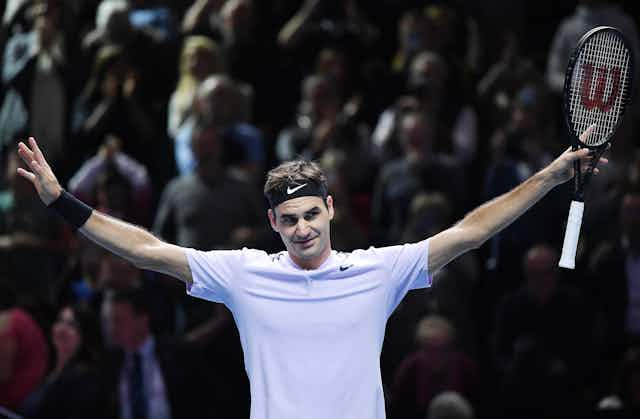In this series we’re looking at how the economics of sports is doing away with hunches and intuition. Using data and research to evaluate players, strategies and even leagues.
Tennis players take on a huge risk in deciding to turn pro - the odds of earning a stable income through tennis, let alone vast riches, are vanishingly small. Our research suggests it’s this very riskiness that drives tennis players to turn professional.
Just like gamblers, tennis players are enticed by the small possibility of a large payoff.
By our calculations an 18 year old boy ranked 100 in the world in 1997 had a less than one-thousandth of a percent (0.001%) chance of earning more than US$10 million in prize money over his tennis career. This isn’t a lot of money when you subtract the cost of competing - which averaged US$38,800 for male players and US$40,180 for female players in 2013, not including the cost of a coach.
We calculated the average career prize earnings of tennis players at around US$300,000. Around 80% of professional tennis players earn close to nothing, but there is a very wide range of values above this that people might earn – up to the US$65 million Roger Federer earned by the age of 30.
As you can see in the chart above, tennis has some of the most extreme levels of inequality in any sport. Highly ranked players, both men and women, can earn significant prize money, while those ranked between 200 and 2,000 earn almost nothing.
Of the 128 players that qualify for each of the four Grand Slam tournaments, the winners take home around 18% of the total prize money. Those who exit in the first round get only 0.3%. This does not factor in the sponsorships and endorsements that top-ranked players receive.
Teenagers who are ranked very highly in the world have a better chance of becoming stars as adults, but they still face a lot of uncertainty. For example, Kristian Pless was ranked number one as a junior but his highest rank as a professional was 65, and he earned just US$1.1 million in prize money over his ten-year career.
Teenagers who are ranked poorly are almost certain to make close to zero over their tennis careers. However, there remains a minuscule chance they could make it big. Our research suggests this small chance of a big payoff is why players decided to continue their tennis careers.
Read more: Rich rewards for those at the top in tennis, but what of the rest?
Both experimental and observational studies of gambling behaviour suggest that people are attracted to a “skewed” gamble - where there is a small possibility of a big payoff.
For example, imagine two lotteries. One pays out either nothing or $1, each with 50% probability. The other has a 50% probability of paying nothing, a 49% probability of paying 80 cents and a 1% probability of paying out $10.
Even though the first lottery has a high average payoff and less uncertainty, the research suggests gamblers are strongly attracted to a skewed gamble, and so to the $10 payoff in the second lottery.
Our research found that this same effect is evident in players’ decisions to continue in tennis (which is a big, career-sized gamble). We found that players whose potential lifetime earnings are highly skewed – so that they had a very low probability of a high payoff – are more likely to stick with tennis for at least one more year.
In other words, tennis players behave the same way when choosing their career path as gamblers do when backing a horse.
Further, boys appear to be more attracted to highly skewed earnings than girls. If we eliminate the tiny chance that they make a massive amount of money, teenage boys would be 20% less likely to continue in tennis from one year to the next, while teenage girls would be 5% less likely.
These effects are much smaller in our study of tennis players than in studies of gamblers. But they are still large, and, combined with the poor earnings prospects for most tennis players, indicate that many would be better off pursuing a different career than trying to be the next Serena Williams.
Read more: Numbers game: the Australian Open and predicting success
This same effect can be seen in many other industries and pay inequality has been increasing in many occupations in recent decades.
Technology, such as television and the internet, may be partly to blame. They have helped create a small number of superstars who are able to capture a lot of the earnings available in a particular occupation. For example, Taylor Swift sells millions of records across the world while countless street performers can only dream of making a living from music.
Our findings also suggest that the existence of superstars may attract people to a particular career.
This is not necessarily irrational – people get pleasure from long-shot chances. But the fact that tennis players appear to be gambling with their careers suggests that many may end up regretting their decisions.

